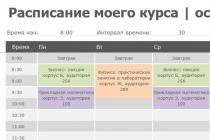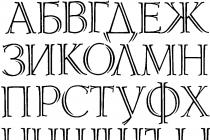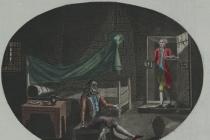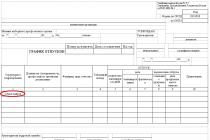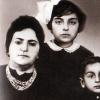On December 12, 1942, Operation Winter Thunder began - the offensive of German troops under the command of Erich von Manstein from the Kotelnikovsky area in order to rescue the 6th Army of Friedrich Paulus in the Stalingrad area.
Actions of the German command
On November 23, 1942, in the area of Kalach-on-Don, Soviet troops closed the encirclement ring around the 6th Army of the Wehrmacht. The command of the 6th Army was preparing to break through the encirclement. The breakthrough was supposed to be made on November 25 after the regrouping necessary to concentrate strike forces in the southwest. It was planned that the army would advance at dawn with its right flank east of the Don to the southwest and cross the Don in the Verkhne-Chirskaya area.
On the night of November 23-24, Paulus sent an urgent radiogram to Hitler, in which he asked for permission to break through. He noted that the 6th Army was too weak and unable to hold the front for long, which had more than doubled as a result of the encirclement. In addition, she had suffered very heavy losses in the past two days. It was impossible to remain surrounded for a long time - large reserves of fuel, ammunition, food and other supplies were needed. Paulus wrote: “Fuel reserves will soon run out, tanks and heavy equipment in this case will be motionless. The ammunition situation is critical. There will be enough food for 6 days.”
Hitler, on the evening of November 21, when the headquarters of the 6th Army, which found itself in the path of the advance of Soviet tanks, moved from the Golubinsky area to Nizhne-Chirskaya, gave the order: “The army commander with his headquarters should go to Stalingrad, the 6th Army will take up a perimeter defense and wait for further instructions." On the evening of November 22, Hitler confirmed his first order: “The 6th Army takes up a perimeter defense and waits for a relief attack from the outside.”
On November 23, the commander of Army Group B, Colonel General Maximilian von Weichs, sent a telegram to Hitler’s headquarters, where he also spoke about the need to withdraw the troops of the 6th Army without waiting for outside help. He noted that supplying an army of twenty divisions by air was impossible. With the existing fleet of transport aircraft, in favorable weather, only 1/6 of the food needed for one day can be transferred to the “cauldron” every day. The army's reserves will quickly run out and can only be stretched out for a few days. Ammunition will quickly be used up as the surrounded troops fight off attacks from all sides. Therefore, the 6th Army needs to fight its way to the southwest in order to maintain it as a combat-ready force, even at the cost of losing most of its equipment and property. Losses during a breakthrough, however, “will be significantly less than during the starvation blockade of the army in the cauldron, to which the events now developing would otherwise lead it.”
The Chief of the General Staff of the Army (OKH), Infantry General Kurt Zeitzler, also insisted on the need to leave Stalingrad and throw the 6th Army to break through the encirclement. The details of the operation to leave the 6th Army from encirclement, scheduled for November 25, were agreed upon between the headquarters of Army Group B and the 6th Army. On November 24, they were waiting for Hitler's permission to surrender Stalingrad and the order for the 6th Army to leave the encirclement. However, the order never arrived. On the morning of November 24, a report from the Air Force command was announced that German aviation would provide supplies to the encircled troops by air. As a result, the high command - Hitler, the head of the OKW (Wehrmacht High Command) Keitel and the chief of staff of the OKW operational leadership Jodl - finally came to the conclusion that the 6th Army would hold out in the encirclement area until it was liberated by releasing large forces from the outside. Hitler told the 6th Army: “The army can trust me that I will do everything in my power to supply it and release it in a timely manner...”.
Thus, Hitler and the Wehrmacht high command hoped not only to free the 6th Army from encirclement, but also to restore the Volga front. Paulus proposed to withdraw the troops, but at the same time he himself admitted that “under certain conditions there were prerequisites for the planned operation to relieve the blockade and restore the front.” The German command needed positions on the Volga in order to maintain the strategic initiative, and as a basis for further waging an offensive war. The supreme military-political leadership of the Third Reich continued to underestimate the enemy. Hitler and his generals clearly saw the situation and the threat of disaster. However, they did not believe in the offensive capabilities of the Russians and believed that the existing forces and reserves of the Red Army were thrown into the Battle of Stalingrad, and that they were not enough to win a complete victory.
At the cost of great efforts, the German command managed to restore the front and stop the further advance of Soviet troops southwest and south of Stalingrad on the outer front of the encirclement. At the turn of the river Chir, the retreat of the 3rd Romanian Army, defeated and thrown back here by Soviet troops, was suspended. In the bend of the Don between the mouth of the river. Chir and the area of Art. Veshenskaya (mainly along the Chir River), the enemy organized a defense. In addition to the 3rd Romanian Army, hastily assembled German battle groups (each up to a reinforced regiment) were pulled together here. Then the fresh 17th Army Corps arrived in the same area, taking up defense along the river. Chir and R. Curve in the Dubovsky area. Units of the German 48th Panzer Corps, defeated by Soviet troops during the encirclement operation, occupied the gap between the 3rd Romanian Army and the 17th Army Corps. Thus, at the turn of the river. The enemy's command created a new defense front near Stalingrad. German troops also managed to create a stable line of defense in the encirclement area.
Meanwhile, in the Kotelnikov area, east of the Don, the 4th Tank Army under the command of Colonel General Hoth was preparing for a strike. In the coming days, she was supposed to break through the encirclement and launch an offensive on a wide front. At the same time, an army group under the command of General of Infantry Hollidt was supposed to attack from the area west of the upper reaches of the Chir from the flank of the enemy advancing to the south. The 48th Panzer Corps, under the command of Panzer General von Knobelsdorff (with headquarters in Tormosin), together with the just arrived 11th Panzer Division and still expected formations, was to advance from a bridgehead east of Nizhne-Chirskaya. However, in the Tormosin area, the Germans failed to create such a strong relief group as was concentrated in the Kotelnikovo area. Attempts to attack in this direction were unsuccessful. In continuous battles, the German 11th Panzer Division suffered heavy losses.

German tank Pz.Kpfw. IV Ausf. G (Sd.Kfz. 161/2) during the repulsion of the offensive of Soviet troops near Stalingrad, in the area of the village of Kotelnikovo. The vehicle is equipped with “eastern” tracks (Ostketten). In the background, a Pz.Kpfw tank. III
Formation of Army Group Don
The preparation and conduct of the release operation was entrusted to Army Group Don, created by OKH order dated November 21, 1942. It was located between Army Groups A and B. The command of this army group was entrusted to Field Marshal Erich von Manstein. It included: the Hollidt task force (in the Tormosin area), the remnants of the 3rd Romanian Army, the 4th German Tank Army (newly created from the control of the former 4th Tank Army and formations arriving from the reserve) and the 4th I am the Romanian army consisting of the 6th and 7th Romanian corps. The Hollidt group as a strike force included the 48th Panzer Corps (with the 11th Panzer Division) and the 22nd Panzer Division; 4th Tank Army - 57th Tank Corps (6th and 23rd Tank Divisions).
Divisions from the Caucasus, from Voronezh, Orel and from Poland, Germany and France were hastily transferred to reinforce Army Group Don. The troops surrounded in the Stalingrad area (6th Army) were also subordinate to Manstein. The group was reinforced with significant reserve artillery forces. Army Group Don occupied a front with a total length of 600 km, from the village of Veshenskaya on the Don to the river. Manych. It consisted of up to 30 divisions, including six tank divisions and one motorized division (16th motorized division), not counting the troops surrounded at Stalingrad. In front of the troops of the Southwestern Front were 17 divisions from the Don Army Group, and 13 divisions (united in the Goth Army Group) opposed the troops of the 5th Shock Army and the 51st Army of the Stalingrad Front.
The freshest and most powerful division was the 6th Panzer Division of Major General Routh (160 tanks and 40 self-propelled guns). This division, along with the 23rd Panzer Division, and then the 17th Panzer Division, was part of the 57th Panzer Corps of Panzer General Kirchner. This corps became the main armored fist, with the help of which the German command tried to make a hole in the encirclement. After heavy winter battles in 1941-1942. In the Moscow area, the 6th Tank Division was transferred to France in May 1942 for replenishment and rearmament; the 11th Tank Regiment, which was armed with Czechoslovakian Skoda-35 vehicles, received new German vehicles instead. The connection had strong personnel. Along with experienced chief corporals, it had a core of non-commissioned officers and officers. The units were well-knit and had combat experience. X. Scheibert (commander of the 8th tank company of the 11th tank regiment) in his book: “It’s 48 kilometers to Stalingrad. Relieving strike of the 6th Panzer Division, December 1942” noted: “The combat effectiveness of the division can be assessed as outstanding. Everyone felt their great superiority over the enemy, believed in the power of their weapons, in the preparedness of their commanders.”
On the morning of November 27, the echelon of the 6th Tank Division arrived in Kotelnikovo. Just at this time, after artillery shelling, Soviet units burst into the city. Within a few minutes the division suffered its first losses. By December 5, the 6th Panzer Division was completely concentrated in the Kotelnikovo area, its motorized infantry and artillery took up defensive positions approximately 15 km east of the city.
Erich von Manstein, placed by Hitler at the head of Army Group Don and given the order to relieve Paulus' Stalingrad group, was a proven commander who gained fame in many operations. Manstein, as commander of the 11th Army, became famous during the conquest of Crimea. For the capture of Sevastopol, Manstein was promoted to the rank of field marshal. Then the 11th Army under the command of Manstein, as having successful experience in siege and assault operations, was transferred for the decisive assault on Leningrad. However, the offensive of the Soviet troops of the Volkhov Front thwarted the plans of the German command. Paulus described him as a military leader who “enjoyed a reputation as a man of high qualifications and operational intelligence and who knew how to defend his opinion before Hitler.”

"Winter Storm"
On December 1, the army group command issued the order to conduct Operation Winter Storm (Operation Wintergewitter, from German Wintergewitter - “winter storm”). The operation plan provided for the following: the 4th Tank Army was to launch an offensive with the main forces from the Kotelnikovo area east of the river. Don. The offensive was scheduled to begin no earlier than December 8th. The army troops were asked to break through the covering front, strike in the rear or flank of the Soviet troops occupying the inner front of the encirclement south or west of Stalingrad, and defeat them. The 48th Tank Corps from the Hollidt group was supposed to hit the rear of the Soviet troops from a bridgehead on the Don and Chir rivers in the Nizhne-Chirskaya area.
The 6th Army was accordingly asked to hold its previous positions in the “cauldron.” However, at a certain moment, indicated by the headquarters of the army group, the 6th Army was supposed to attack in the southwestern sector of the encirclement front in the direction of the river. Donskaya Tsarina and link up with the advancing 4th Tank Army.
Thus, Manstein decided to launch the main attack from the Kotelnikovo area. Although the German troops entrenched at the turn of the river. Chir near Nizhne-Chirskaya were only 40 km from the encircled troops of Paulus, while the Kotelnikov group (Army Group "Goth") was removed from them before the start of the offensive at a distance of 120 km. Nevertheless, Manstein decided to attack from here.
This was largely due to the difficult situation on the river. Chir, which was formed for the German troops. As soon as Soviet troops strengthened the encirclement, they immediately began attacks on enemy positions along the river. Chir. The center of these attacks was the lower reaches of the river and the bridgehead at its mouth near the Don. As a result, the Germans exhausted all offensive options here. The troops, united under the command of the 48th Tank Corps, repelled these attacks. However, when the Hollidt strike group, intended as the main force for the relief operation, managed to approach the German defensive front along the river at the end of November. Chir, the newly created 48th Tank Corps has already exhausted its strength. Thus, the 48th Tank Corps was not only unable to facilitate the unblocking counterattack through an operation from the Chir bridgehead, moreover, it was forced to surrender this position, which was closest to the troops encircled in Stalingrad, on December 15th.
The German command postponed the start of the relief strike to December 12. This had to be done due to the delay in the concentration of troops intended for the offensive. Hollidt's group did not have time to take the initial positions for the attack due to insufficient road capacity, and the 4th Panzer Army was awaiting the arrival of the 23rd Panzer Division, which was delayed due to a thaw in the Caucasus. In addition, Manstein had to abandon the idea of two strikes. Thus, of the seven divisions intended for the Hollidt group, two were already involved in battles on the front of the 3rd Romanian Army, and the operational situation did not allow them to be recalled. The 3rd Mountain Division did not arrive at all; by OKH order it was transferred to Army Group A, and then to Army Group Center. Army Group A also detained the reserve artillery of the main command. The activation of Red Army units on the front of the 3rd Romanian Army exhausted the capabilities of the 48th Tank Corps, which could not simultaneously repel attacks and launch a counteroffensive. Thus, Manstein decided to abandon two unblocking strikes. It was finally decided that the main blow was to be delivered by the 4th Tank Army.
On December 11, Manstein gave the order to begin the operation. The situation on the southern sector of the front deteriorated, and it was necessary to advance. They decided to strike with the forces of the 6th and 23rd tank divisions, which were later joined by the 17th tank division. Manstein proposed to General Paulus to launch a counter strike from the Stalingrad area.
6th Army 1st Formation
formed in September 1939 in the Kiev Special Military District on the basis of the Eastern Army Group of Forces.
By the beginning of the Great Patriotic War, the army (6th, 37th rifle, 4th and 15th mechanized corps, 5th cavalry corps, 4th and 6th fortified areas, several artillery and other units) was deployed as part of the Southwestern Front in the Lvov direction at the Krystonopol - Grabovets line and participated in the border battle northwest of Lvov. Then she fought heavy defensive battles and, under attacks from superior enemy forces, was forced to retreat to Brody, Yampol, and Berdichev.
In July - early August 1941, as part of the Southern Front (from July 25), army troops participated in the Kiev strategic defensive operation (July 7 - September 26), repelling the enemy's offensive in the Uman direction.
After heavy fighting southeast of Uman on August 10, 1941, the army was disbanded, and its troops were transferred to complement other armies of the Southern Front.
Army Commander - Lieutenant General Muzychenko I. N. (June - August 1941)
Member of the Military Council of the Army - Divisional Commissar Popov N.K. (June 1940 - August 1941)
Chief of Army Staff - Brigade Commander Ivanov N.P. (May - August 1941)
6th Army 2nd Formation
formed on August 25, 1941 as part of the Southern Front on the basis of the 48th Rifle Corps. It included the 169th, 226th, 230th, 255th, 273rd, 275th rifle divisions, 26th and 28th cavalry divisions, 8th tank division, 44th fighter aviation division, artillery, engineering and other units. After formation, it defended the line along the left bank of the Dnieper, north-west of Dnepropetrovsk.
On September 27, 1941, as part of the Southwestern Front, the army fought during the Donbass defensive operation, in January 1942 it participated in the Barvenkovo-Lozov offensive operation (January 18-31), in May - in the Kharkov battle (May 12-29 ).
On June 10, 1942, the field command of the army was disbanded, and its troops entered the reserve of the Southwestern Front as they emerged from encirclement.
Army commanders: Major General, from November 1941 - Lieutenant General R. Ya. Malinovsky (August - December 1941); Major General, from March 1942 - Lieutenant General A. M. Gorodnyansky (January - June 1942)
Members of the Army Military Council: brigade commissar K. V. Krainyukov (August - September 1941); Brigade Commissioner Larin I.I. (September - December 1941); divisional commissar E. T. Pozhidaev (December 1941 - April 1942); brigade commissar L. L. Danilov (April - June 1942)
Chiefs of Army Staff - brigade commander, from November 1941 - Major General A.G. Batyunya (August 1941 - April 1942); Colonel Lyamin N.I. (April-June 1942)
6th Army 3rd Formation
formed on July 7, 1942 on the basis of the 6th Reserve Army in the reserve of the Headquarters of the Supreme High Command. It included the 45th, 99th, 141st, 160th, 174th, 212th, 219th and 309th rifle divisions, the 141st rifle brigade, several artillery and other formations and units.
In July 1942, as part of the Voronezh Front (from July 9), the army participated in the Voronezh-Voroshilovgrad strategic defensive operation (June 28 - July 24), in August it fought offensive battles, during which it liberated the city of Korotoyak and to the north it captured two small bridgeheads on the right bank of the Don.
In December 1942, the army as part of the Voronezh, from December 19, 1942 - South-Western (2nd formation, from October 20, 1943 - 3rd Ukrainian) fronts participated in the Middle Don offensive operation (December 16-30), and at the end of January - February 1943 - in the operation to liberate Donbass and in repelling the counter-offensive of German troops south of Kharkov.In the Donbass operation, the army fought about 250 km, liberated the city of Lozovaya (September 16) and by the end of the operation, its left flank reached the Dnieper, crossed it and captured a bridgehead in the Zvonetskoye and Voiskovoe districts.
In the winter and spring of 1944, army troops successively participated in the Nikopol-Krivoy Rog (January 30 - February 29), Bereznegovato-Snigirev (March 6-18) and Odessa offensive operations (March 26 - April 14).
In June, the troops of the 6th Army were transferred to the 37th and 46th armies, and its field control was transferred to the front reserve, and from July 18 to the reserve of the Supreme High Command Headquarters.
In December 1944, field control was transferred to the 1st Ukrainian Front and in the Sandomierz area it received part of the troops from the 3rd Guards and 13th Armies.
In January - February 1945, the army took part in the Sandomierz-Silesian (January 12 - February 3) and Lower Silesian (February 8-24) offensive operations. In March and early May, its troops fought to eliminate an encircled group of enemy troops in the Breslau (Wroclaw) region.
The army was disbanded in September 1945; its field management was turned to staffing the administration of the Oryol Military District.
Army commanders: Major General, from December 1942 - Lieutenant General F. M. Kharitonov (July 1942 - May 1943); Lieutenant General Shlemin I.T. (May 1943 - May 1944); Major General Kulishev F.D. (June - August and September - December 1944); Colonel General V. D. Tsvetaev (September-September 1944); Lieutenant General V. A. Gluzdovsky (December 1944 - until the end of the war).
Members of the Military Council of the Army: Corps Commissar Mehlis L. Z. (July - September 1942); Divisional Commissioner, from December 1942 - Major General of Aviation V. Ya. Klokov (October 1942 - until the end of the war).
Chiefs of Army Staff: Colonel Eremin N.V. (July - August 1942); Colonel Protas S. M. (August - November 1942); Major General Afanasyev A.N. (November 1942 - February 1943); Colonel Fomin B.A. (February - March 1943); Major General Kulishev F.D. (March 1943 - September 1944 and December 1944 - until the end of the war);Colonel Simanovsky N.V. (September - December 1944)
The whole world knew about the encirclement of the 6th German Army, but German propaganda did not utter a word about it. She carefully concealed the fact that the Red Army had completed the encirclement of this army and was successfully fighting to destroy it. As early as January 25, German radio boastfully asserted: “If our soldiers are retreating in some places, it is only so that, having reorganized and replenished their material forces, they can launch a new offensive.” However, you can’t hide an awl in a bag. On the same day, a few hours later, a new, unexpected note comes through in radio broadcasts: “In the Stalingrad area, the situation has significantly worsened... The enemy managed to crush our front line... His offensive was preceded by a literal fire barrage of unimaginable force, after which his tanks rushed along the mutilated trenches of our grenadiers... The ring around Stalingrad has shrunk even tighter.” But on February 1, the German information bureau reported “the news of the end in Stalingrad.” It was forced to admit the “loss of the army” and thereby emphasize “the seriousness of the failure suffered.” Next, Goebbels' department makes a stunning historical discovery. It compares the defeat of the Germans at Stalingrad with the largest defeats in the history of war and then tries to prove that these defeats were... victories!
As you know, the Russian people have beaten the German invaders more than once in the past. Thus, the Teutonic knights suffered a severe defeat at the Battle of Tannenberg. But it turns out, as the German news bureau reported on February 1, that the German people are proud of Tannenberg. The Russian army defeated Frederick II at Kunersdorf, but it turns out that the Germans should be proud of this too. Finally, the German information bureau believes that “Napoleon’s greatest deed, according to military historians, was not Austerlitz, but the crossing of the Berezina, which he accomplished during his retreat from Moscow in the face of two Russian armies located on both sides of the river.” Which “military historians” can prove that Napoleon’s defeat in Russia and his flight across the Berezina is his victory is Goebbels’ secret. It is known that Schlieffen wrote something opposite on this issue: “Only Berezina puts the stamp of the most terrible Cannes on the Moscow campaign.” But if we continue the analogy, the position of the 6th German Army turned out to be much worse than that of Napoleonic troops retreating from Moscow: it was unable to leave, was surrounded and is now completely destroyed. If Goebbels’ department is still trying to prove that the defeat of the 6th Army at Stalingrad is a “victory,” then we can say: a few more such “victories” and humanity will be freed from the Hitlerite horde.
The balancing act of German propaganda has another very important background. The fact is that in the Stalingrad area it was not a random group of German troops that was destroyed, but the flower of the German armed forces, an army that had traveled a victorious path through the countries of Europe and was led by some of the major German generals.
Hitler was proud of his 6th Army, its enormous striking force, its officers and soldiers. The personnel divisions of the 6th Army were formed almost exclusively from pure-bred Aryans - in Brandenburg, in Dresden, in Baden-Baden. Some units, such as the 79th Infantry Division, formed in August 1939, consisted almost exclusively of youth between the ages of 22 and 28 - youth, . Many of the soldiers were avowed Nazis. According to the testimony of prisoners, in some units there was at least one member of the Nazi Party for every five soldiers.

Hitler entrusted the 6th Army with the most important tasks. She was supposed to strike the first blow to the West. On May 10, 1940, the 6th Army, on Hitler's orders, treacherously invaded little Belgium. Having broken the resistance of the Belgian army on the line of the Albert Canal, the 6th Army, like a whirlwind, swept across the country, spreading death and destruction everywhere. During the campaign in France, the 6th Army was part of Group B, commanded by the notorious Colonel General Bock. The 6th Army was then headed by Colonel General Reichenau. Personnel divisions of the 6th Army marched through many countries of Western Europe. After the campaign against Brussels and Paris, they took part in the conquest of Yugoslavia and Greece. Even before the war, they tasted the intoxicating fruits of easy victories: they participated in the occupation of Czechoslovakia.
From the first day of the war with the USSR, Hitler threw the 6th Army to the east. It was she who, bleeding, fought her way from Kharkov to Stalingrad in 1942. It was she who was entrusted by Hitler with the implementation of the most important part of his delusional strategic plan -. At the head of the 6th Army, he placed generals with extensive practical experience of two world wars, as well as experience in preparing for these wars. The Soviet generals, who carried out Stalin’s plan to defeat the German group with such brilliance and skill, had experienced and dangerous opponents before them.
The commander of the 6th Army, Friedrich Paulus, is. He is 53 years old, 33 of which he was in the army. During the war of 1914-1918. he was a combat officer, and by the end of it he became an officer of the general staff. Paulus then took part in operations on the western front, in the Balkans and on the southern front. After the defeat of the German army in 1918, von Paulus did not resign. He served for a long time in the War Ministry, and then was chief of staff of the Tank Forces Directorate. Thus, he took an active part in the preparations for the Second World War.
Hitler immediately promoted Paulus, appointing him to a very responsible post - chief of staff of the army, Field Marshal Reichenau. Together with her, Paulus crossed Poland in the fall of 1939, and the following year took part in the defeat of France. Shortly after Petain's surrender, in September 1940, Paulus was appointed Chief Quartermaster of the General Staff of the German Army. Thus, by the time of Hitler’s Germany’s predatory attack on the Soviet Union, Paulus had already played a major role among Hitler’s generals. In January 1942, he was promoted to general of tank forces, and a year later received the rank of colonel general. But at this time he, along with his entire 6th Army, was already surrounded. At the height of the fighting, when the Red Army was tightening its iron ring and inflicting terrible blows on the encircled German group, Hitler awarded Paulus an oak leaf to the knightly Order of the Iron Cross. He then awarded Paulus the rank of Field Marshal. But the next day Paulus.
On February 3, Hitler still tried to deny this fact. He seeks to brighten up the failure of his strategic plans by creating an artificial halo around the 6th Army. For this purpose, his headquarters published a special addition to the summary: “Loudspeakers offer to surrender in German, but everyone, without exception, continues to fight where they stand.” All without exception? Hitler knows that this is a lie, and an easily exposed one at that. Further, he still notes melancholy: “Few German and Allied soldiers surrendered alive to the Soviet troops.” A few are more than 91 thousand soldiers, i.e. almost a third of Paulus's entire army. Hitler still prefers to remain silent about his 2,500 officers, about 24 generals, and finally about Field Marshal Paulus himself, who were taken prisoner. However, the fate of the entire army cannot be silenced! And on the same day, Hitler’s headquarters published a special message: “The 6th Army under the exemplary command of von Paulus has been defeated.” Defeated is a completely new word for Hitler, who back on January 30, through the mouth of Goebbels, declared that the word “surrender” had been forever erased from the German lexicon.
The Red Army defeated one of the most powerful fascist armies, formed from selected units, extremely rich in equipment, and with experienced command. Hitler consoles the Germans: “new divisions of the 6th Army are already being formed.” But everyone understands that these will be ersatz divisions. They will suffer the same fate. They will be crushed, just as the personnel divisions of the 6th German Army were crushed in the Stalingrad area. // Lieutenant colonel .
_____________________________________
("Red Star", USSR)*
("Pravda", USSR)
IN LIBERATED STALINGRAD. German cars captured among the rich trophies.
A photo of our special photocorr. A. Kapustyansky. Delivered by plane piloted by Senior Lieutenant Shchupakowski 
**************************************** **************************************** **************************************** **************************
Stalingrad celebrates victory
Rally of city defenders and residents
Snow-covered Square of Fallen Fighters, pitted by bombs and shells. In its center lies a broken German bomber. Dead cars stand on tram lines, riddled with bullets and shell fragments. Around the square are the ruins of multi-storey buildings. The burnt building of the Central Department Store, the destroyed post office building, the House of Books, the House of the Commune, in which Comrade Stalin held a meeting in 1918 on the issue of food in the south of Russia. The broken building of the city theater, where a lion with its head pierced by bomb fragments survived on the steps of the entrance.
The Square of Fallen Fighters looks stern and strict today. Miraculously, the monument to the 54 Red Army soldiers who died during the defense of Tsaritsyn survived in its center. Just three days ago there was a battle here with the remnants of a German group. Today, on this square of heroic Stalingrad, cleared of the fascist pack, the defenders of the city and its residents gathered to celebrate the glorious victory over the sworn enemy. The square is decorated with red victory banners.

On the podium of the rally are N.S. Khrushchev, Chuyanov, generals Chuikov, Shumilov, Rodimtsev, the chairman of the city council Pigalev, the secretary of the city committee of the Piksin party, many other commanders of the Stalingrad army and leaders of city organizations. At 12 noon comrade. Pigalev opens the meeting. On behalf of the working people of the city, he warmly thanks the winners of the Battle of Stalingrad - the fighters and commanders of the Don Front:
The days of the most difficult trials are left behind. Forever glory to the heroes of Stalingrad, whose blood won victory! Glory to our brave soldiers and commanders, glory to Comrade Stalin!
Comrade Pigalev gives the floor. This name is well known to the entire Red Army, to the entire Soviet people. A talented military leader, holder of the Order of Suvorov, 1st degree, performs in the city that his troops defended during the most difficult days of the siege.
Comrades, says General Chuikov, today, in these moments, we remember all the days of the heroic defense of the city. We, we did not surrender the city that bears the name of the great Stalin to the enemy. Our soldiers knew that the fate of their homeland was in their hands, that the homeland remembered its army and warmed it with maternal care...
The soldiers of the 62nd Army listen to the speech of their commander and remember what efforts this historic victory cost. Their thoughts are carried away to the hot days of battle. They see their general appearing in the most critical battle areas. The general was always with the troops, experiencing with them both the bitterness of failure and the joy of victory.
Comrade Chuikov talks about the glorious defenders of Stalingrad, about talented commanders and courageous fighters, and about the fact that ardent faith in the triumph of our cause brought success.
What the Germans received at Stalingrad were flowers,” the general ends his speech. - The final reckoning with Hitler’s army is yet to come. For the destruction of Stalingrad, for our fallen comrades, we will repay the enemy in full. We know that the historic victory at Stalingrad will affect the entire course of the war. We will crush and destroy the enemy, expelling him from the borders of our homeland.
Comrade Chuikov proclaims a toast in honor of the Supreme Commander-in-Chief, Comrade Stalin. A multivocal “hurray” thunders across the square.
The commander of the 13th Order of Lenin Guards Division, Hero of the Soviet Union Guard, Major General Rodimtsev, speaks:
The guards withstood the onslaught of a numerically superior enemy. Their tenacity and resilience were not broken. The names of the guardsmen - staunch defenders of the Volga stronghold - will be forever written in the chronicle of the great Battle of Stalingrad. Today our division celebrates 140 days of its stay in Stalingrad. On the very first day, we pushed back the enemy and prevented him from spreading in the city. Then I told the commander: the guards came to Stalingrad, and they would rather die than leave it. The guardsmen fought to the death, and, having survived, they won. It’s hard for us to look at this tormented city, in which there is not a single inch of land where there are no cruel traces of war. And each of us passionately desires revenge. The enemy paid us for this with hundreds of thousands of his soldiers and officers. Here, among the ruins of the city, we swear to our homeland and the Supreme Commander-in-Chief, the great Stalin, to continue to beat the enemy like the Guards, like Stalingrad.
On the podium is Lieutenant General Shumilov. His troops fought with the Germans on the distant approaches to Stalingrad and did not allow the enemy to reach the Volga to the south of the city.
On February 2, 1943, says the general, we heard the last shot in Stalingrad. With the surrender of the northern group of Germans, an operation unprecedented in history, carried out according to the brilliant strategic plan of Comrade Stalin, ended. Our soldiers stopped the Germans, did not let them near the Volga, and Stalingrad became the grave for the fascist invaders.
The speaker is the secretary of the Stalingrad Regional Committee of the All-Union Communist Party of Bolsheviks and member of the Military Council of the front, Comrade. Chuyanov. He talks about how the whole country helped the courageous defenders of Stalingrad.
Comrade Stalin personally supervised the defense of the city. During difficult days, the Secretary of the Central Committee of the All-Union Communist Party of Bolsheviks, Comrade Malenkov, came here to the burning city. The talented General Eremenko and the staunch Bolshevik, a faithful disciple of Comrade Stalin, N.S. Khrushchev, were sent here.
Our city is burned, tormented, wounded, says Comrade. Chuyanov, - you see the ruins of Stalingrad. We swear to our party and homeland that we will restore Stalingrad, and its powerful industry will once again forge victory over Hitler’s army.
The troops and workers of Stalingrad greeted with a stormy ovation the appearance on the podium of a member of the Military Council of the front, Comrade N.S. Khrushchev. His bright speech dedicated to the defenders of Stalingrad is listened to with intense attention.
Comrades, says N.S. Khrushchev, we have gathered here today on a historic day when our soldiers, having completed the defeat of the Germans in the Stalingrad area, are celebrating their glorious victory over their sworn enemy. The Germans failed to escape from the Volga. Today, like old friends, we have gathered together after a long separation, looking at each other. Each of us has a lot to say.
Comrade Khrushchev talks about the enormous role of the 62nd Army, about its commander, Comrade. Chuikov, member of the Military Council, Lieutenant General Gurov.
Anyone who was here knows how difficult it was for the 62nd on the banks of the Volga under enemy fire. The army under the command of General Shumilov also played a major role. This army also had to endure heavy battles with the enemy...
All our efforts, says comrade in conclusion. Khrushchev, - should be aimed at improving military skills. The day is not far when the victorious banner of Lenin-Stalin will once again flutter over all the cities of our homeland. Our cause is right, true, we will defeat the enemy! Long live the glorious Red Army! Long live our glorious soldiers and commanders - the defenders of Stalingrad! Hurray for our Stalin!
“Hurray” thunders in the square in honor of the great commander Supreme Commander-in-Chief Comrade Stalin, in honor of the Red Army he led, in honor of the courageous defenders of Stalingrad.
Stakhanovite N plant comrade speaking. Sidnev. He warmly thanks the troops on behalf of the working people of Stalingrad and declares the workers’ readiness to tirelessly forge powerful weapons for the final victory of the Red Army.
Secretary of the city committee of the CPSU(b) comrade. Pixin announces a greeting to the People's Commissar of Defense, Comrade Stalin. Once again “hurray” is heard in the square. The troops and workers once again greet their leader, whose name the victorious city bears. // Major . Senior Lieutenant .
______________________________________
* (Izvestia, USSR)
("Red Star", USSR)
**************************************** **************************************** **************************************** **************************
CHANGE OF PROGRAM. In connection with the defeat and destruction of German troops at Stalingrad, mourning was declared throughout Germany and all entertainment establishments were closed.
Rice. B. Efimova. 
**************************************** **************************************** **************************************** **************************
Stalingrad
Oh, you standards of grandfather's victories,
Russia's majestic joy!
Having dispelled
Hitler's
Rave,
The banner of Stalingrad is burning among you.
Its lights burn like orders,
He is the true heir of your glory,
In it is the wind that flew from Poltava,
And Borodin's gunpowder smoke.
Fighters of the Caucasus! Before Stalingrad,
Out of respect for his banner
Bow the banner, but only to
So that they would then make noise nearby.
So that, covering yourself with immortality,
Like Stalingrad, we would drive the horde.
There is a jubilant rush of rage here,
Here honor gives birth to honor, and glory to glory.
**************************************** **************************************** **************************************** **************************
AWARD OF THE MARSHAL'S INDICATOR "MARSHAL'S STAR" AND THE ORDER OF SUVOROV OF THE FIRST DEGREE.
February 4th in the Kremlin, Chairman of the Presidium of the Supreme Soviet of the USSR, comrade. Kalinin M.I. presented the marshal's insignia "Marshal's Star" and the Order of Suvorov, first degree, to Marshal of the Soviet Union comrade. Zhukov G.K.
The Order of Suvorov, first degree, was awarded to Comrade. Kalinin M.I. Colonel General of Aviation Comrade Novikov A.A. and Lieutenant General of Aviation Comrade. Golovanov A.E.
IN THE PICTURE: Comrade. M.I. Kalinin congratulates comrade G.K. Zhukov on receiving the “Marshal’s Star” and the Order of Suvorov, 1st degree. In the center is the Secretary of the Presidium of the Supreme Soviet of the USSR A.F. Gorkin. Photo by F. Kislov. (TASS photo chronicle).

________________________________________ ______
|| "Pravda" No. 27, January 27, 1943
* || Izvestia No. 14, January 17, 1943
* || Izvestia No. 26, February 2, 1943
|| "Pravda" No. 31, January 31, 1943
|| "Red Star" No. 10, January 13, 1943
The Sixth Field Army of the Wehrmacht was formed in October 1939. With the outbreak of World War II, she took an active part in military operations on the Western Front against France. From the first days of Germany's attack on the Soviet Union, the 6th Army operated on the Soviet-German front under the command of Field Marshal Walter von Reichenau, who was distinguished by his fanatical devotion to the ideas of National Socialism and Hitler personally. Under his command, the 6th Army, in addition to combat operations, carried out punitive measures in temporarily occupied Soviet territory. From January 1942, Colonel General Friedrich Paulus became the commander of the 6th Army, under whose leadership the 6th Army entered the battle of Stalingrad in the summer of 1942.
Failed triumph
If Operation Uranus predetermined the inevitable defeat of the 6th Army, then the implementation of Operation Ring by the troops of the Don Front ultimately led to the complete elimination of this army as a combat-ready formation of the Wehrmacht.
The 6th Army was doomed to inevitable defeat from the moment it was surrounded in the Stalingrad area by superior numbers and weapons of the Red Army, and Hitler forbade it to leave the “fortress of Stalingrad.” The German High Command associated the salvation of the 6th Army from the impending disaster with the establishment of an “air bridge” to Stalingrad and its rescue from encirclement with the help of powerful relief forces of the Wehrmacht operating south of the city on the Volga.
Being one of the elite formations of the Wehrmacht, the 6th Army actively took upon itself the implementation of gendarmerie punitive functions in the occupied Soviet territory. It turned into one of the effective means of carrying out the occupation policy of the Nazi elite. This policy of plundering the national wealth of the Soviet state, enslaving and exterminating its people was based on the notorious Ost plan.
To implement it, special bodies were created within the 6th Army to carry out economic robbery, deportation of Soviet citizens for forced labor in Germany, as well as involving the civilian population of Stalingrad in military work in the combat area.
Recently, publications have appeared that show what kind of violence, oppression and bullying the civilian population of Stalingrad was subjected to by soldiers and officers of the 6th Army. In addition to the Germans, their allies were distinguished by particular outrage and brutality: Hungarians, Romanians, Croats and “volunteers” - Ukrainians. After the encirclement of the 6th Army, the situation of the civilian population of Stalingrad became especially unbearably difficult: the vast majority of them were threatened with starvation, as the occupation authorities confiscated all food and warm clothing from them.
It was possible to establish that more than 28% of those who survived the August bombing remained in the occupied territory of Stalingrad. However, there is still no exact information about the number of Stalingrad residents who were driven away from Stalingrad for forced labor. It is believed that between September 27 and November 2, 1942, 38,000 inhabitants left Stalingrad. In addition, by the end of October 1942, over 40,000 people had fled from the Stalingrad area. The total number of “registered” refugees was approximately 80 thousand people, and only 72 thousand people passed through the camp in Belaya Kalitva. The remaining 8 thousand prisoners apparently died for various reasons. According to official data of the German occupation authorities, out of 25 thousand civilians, about 13 thousand people were involved in various forced labor, including about 4,000 who were taken for slave labor in Germany and about 5 thousand people were used for the “needs” of the Wehrmacht and the Todt organization.
The 6th Army also operated camps for Soviet prisoners of war, which were kept in inhumane conditions. Thus, only in the camps located in the area of Voroponovo and Gumrak, out of 3,500 prisoners of war, only 20 people survived.
"Stalingrad Cauldron"
It cannot be said categorically that the German High Command did not see the threat hanging over the 6th Army. Despite repeated attempts by the Chief of the General Staff of the Ground Forces, Kurt Zeitzer, to withdraw the army from Stalingrad, the Fuhrer was categorically against this and ordered the operation to continue.
In order to survive and continue to fight, the 6th Army needed both  minimum 600 tons of cargo per day. Reichsmarschall Hermann Goering, who oversaw the German air force, convinced Hitler that the Luftwaffe could provide a minimum supply by air. However, the military official did not take into account winter weather conditions and changes at the front, which forced the air fleet bases to be moved further to the west. As a result, the 6th Army received nothing at all on many days, and on others, instead of the daily minimum of 600 tons, at most 140 tons arrived, but most often only 80-100 tons.
minimum 600 tons of cargo per day. Reichsmarschall Hermann Goering, who oversaw the German air force, convinced Hitler that the Luftwaffe could provide a minimum supply by air. However, the military official did not take into account winter weather conditions and changes at the front, which forced the air fleet bases to be moved further to the west. As a result, the 6th Army received nothing at all on many days, and on others, instead of the daily minimum of 600 tons, at most 140 tons arrived, but most often only 80-100 tons.
It should be noted that thanks to the successful actions of the Soviet formations, the “air bridge” began to collapse: cargo supplies began to decrease to a critical level until they stopped completely by the end of January 1943. In the period from November 24, 1942 to January 31, 1943, Luftwaffe losses on the air bridge route amounted to 488 aircraft. From the beginning of the bridge’s operation until January 24, 42 thousand wounded, sick and specialists were evacuated. In total, during the operation of the “air bridge”, the 6th Army received 6591 tons of cargo, an average of 72.9 tons of cargo per day.
As a result of the successful completion of the final operation of the Red Army “Ring”, the encircled enemy group in the Stalingrad area ceased resistance. And on the banks of the Volga, an unprecedented battle that lasted 200 fiery days and nights ended. In terms of scope, duration, intensity and the number of forces participating, the Battle of Stalingrad had no equal in world history. The battle took place over an area of 100,000 square kilometers with a front length of 400 to 850 kilometers. At certain stages of the Battle of Stalingrad, over 2 million people simultaneously participated on both sides. Human. During the counter-offensive of the Soviet troops, not only the 6th Army, but also the 4th German Army, 8th Italian, 3rd and 4th Romanian armies were completely defeated.
Conflicting Statistics
The command of the 6th Army never formally announced the surrender of its forces. Soviet troops captured all the surviving soldiers and officers of the encircled group. However, there is still no accurate data on the number of enemy forces captured at Stalingrad. It is believed that Field Marshal Paulus and 24 other generals surrendered with the remnants of their troops numbering 91 thousand people. Subsequently, our troops buried 140,000 enemy soldiers and officers on the battlefield. The following data is also available: the estimated number of enemy prisoners of war for the entire period of the Battle of Stalingrad is 239,775 people.
As for the mass death of prisoners of war from the “Stalingrad Cauldron”, most of them died during the first year of their captivity due to exhaustion, the effects of cold and numerous diseases. Only in the period from February 3 to June 10, 1943, in the German prisoner of war camp in Beketovka, the consequences of the “Stalingrad Cauldron” cost the lives of more than 27 thousand people, and of the 1,800 captured officers by April 1943, only a quarter remained alive.
Captivity in Crimea
The situation of prisoners of war in Stalingrad, as well as throughout the country, was determined by the norms of the relevant international legal acts. Relations with prisoners of war were built in accordance with the requirements of army regulations. Officers were assigned to separate camps, and social settlements were designated for senior command personnel. But Field Marshal Paulus could live in a dacha in Tomilino near Moscow and visit one of the resorts in Crimea. The attitude of the local population towards prisoners of war, as a rule, was universally humane and friendly.
To understand the peculiarities of the evolution of the political consciousness of a career officer who was in Soviet captivity, it is of great interest to get acquainted with the diary of Field Marshal Paulus, which he kept from 1943 to 1949. NKVD intelligence played a major role in this process of understanding new values. It was with her help that the captive Paulus was able to receive letters from his wife from warring Germany in 1944. After reading them, the field marshal without hesitation took the side of yesterday's enemy and began to cooperate with the Soviet Union, never regretting it.
Paulus's career was inextricably linked with the rise of the National Socialist regime in Germany. That is why the question is not at all rhetorical: for what purpose did the ruling Nazi elite in February 1943 declare mourning for the defeated 6th Army led by Field Marshal Paulus? The answer to this question may not always be clear. But in the context of the beginning of the irreversible crisis of the Nazi regime, which had entered its decline, this regime needed fallen heroes (Paulus was included among them with unprecedented tragic pathos), the myth of whose heroic deeds was supposed to raise the authority of National Socialism.
The victorious outcome of the Battle of Stalingrad decisively determined the outcome of World War II. “The Second World War, the outcome of which determined Stalingrad in so many ways, ended with the atomic bombing of the cities of Hiroshima and Nagasaki in 1945. The advent of the nuclear era meant that battles such as Stalingrad. Will never. The greatest battle of the last great war before atomic times was an epic confrontation that will never be surpassed,” wrote British military historian Robert Jeffrey.
6th Army I Formation formed on September 28, 1939 in the Kiev OVO on the basis of the Vinnitsa Army Group of Forces, created by order of the USSR NKO No. 0152 dated July 26, 1938 on the basis of the control of the 17th infantry regiment. By the beginning of the Great Patriotic War, the 6th Army (6th, 37th rifle, 4th and 15th mechanized and 5th cavalry corps, 4th and 6th fortified areas, a number of artillery and other units) was deployed as part of the Southwestern Front in the Lvov direction at the Krystonopol, Grabovets line and participated in the border battle northwest of Lvov. Then she fought heavy defensive battles and, under attacks from superior enemy forces, was forced to retreat to Brody, Yampol, and Berdichev.
In July - early August 1941, as part of the Southern Front (from July 25), she participated in the Kyiv strategic defensive operation, repelling the enemy offensive in the Uman direction. After heavy fighting southeast of Uman. On August 10, 1941, it was disbanded, and its troops were transferred to complement other armies of the Southern Front.
6th Army II Formation formed on August 25, 1941 by directive of the Supreme Command Headquarters No. 001259 of August 25, 1941 as part of the Southern Front on the basis of the 48th Rifle Corps. It included the 169th, 226th, 230th, 255th, 273rd, 275th rifle divisions, 26th and 28th cavalry, 8th tank, 44th fighter aviation divisions, a number artillery, engineering and other units. After formation, it defended the line along the left bank of the Dnieper north-west of Dnepropetrovsk.
6th Army III Formation formed on July 7, 1942 on the basis of the 6th Reserve Army in the reserve of the Supreme Command Headquarters.
It included the 45th, 99th, 141st, 160th, 174th, 212th, 219th and 309th rifle divisions, 141st rifle brigade, a number of artillery and other formations and units .
In July 1942, as part of the Voronezh Front (from July 9), she participated in the Voronezh-Voroshilovgrad strategic defensive operation. In August, she waged offensive battles, during which she liberated the city of Korotoyak and, to the north, captured two small bridgeheads on the right bank of the Don. In December, the army as part of the Voronezh, from December 19, 1942 - South-Western II formation (from October 20, 1943, 3rd Ukrainian) fronts participated in the Middle Don offensive operation, and at the end of January - February 1943 - in the operation for the liberation of Donbass and in repelling the counter-offensive of German troops south of Kharkov. In the Donbass operation, the army fought about 250 km, liberated the city of Lozovaya (September 16) and by the end of the operation, its left flank reached the Dnieper, crossed it and captured a bridgehead in the Zvonetskoye and Voiskovoe areas.
In the winter and spring of 1944, it consistently participated in the Nikopol-Krivoy Rog, Bereznegovato-Snigirev and Odessa offensive operations.
In June, the troops of the 6th Army were transferred to the 37th and 46th armies, and its field control was transferred to the front reserve, from July 18 - to the reserve of the Supreme High Command Headquarters; in December it was transferred to the 1st Ukrainian Front and in the Sandomierz area received part of the troops from the 3rd Guards and 13th armies. In January - February 1945, the army took part in the Sandomierz-Silesian and Lower Silesian offensive operations. In March - early May, she fought to eliminate an encircled group of enemy troops in the Breslau (Wroclaw) area.
In September 1945, the army was disbanded, its field administration was turned to staffing the administration of the Oryol Military District.



